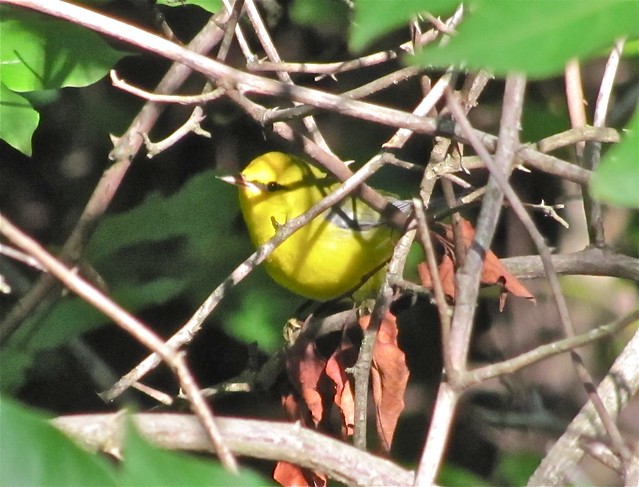
I had a nice morning at Ewing Park today. There were pockets of Warblers, mostly American Redstarts (all female or first year males), but I did see five other Warbler species and a few other migrants. As I began walking in Hedge Apple Woods, I noticed a female Redstart and a Rose-breasted Grosbeak. As I walked down the trail in the grassy area, which is getting overgrown, I saw several Warblers flying around. I was able to get some good looks at this pair of first winter Bay-breasted Warblers. When I first made this post I did not realize that young Bay-breasted Warblers look so much like Pine Warblers, so I thought they were Pine Warblers, but now realize I was mistaken. When I looked in my Sibley guide after writing the initial report, I realized that Pine, Bay-breasted, and Blackpoll Warblers can all be easily confused in the Fall. Then I got an e-mail from Wes Kolb, who thought they might be Bay-breasted because of the buff or bay under the wing. The next day, I ran into Matthew Winks, who also suggested Bay-breasted and reminded me that Pine Warblers move slower than other Warblers. These warblers were moving much faster than the Pine Warblers I saw this Spring. Matt Fraker had e-mailed me by the time I got back from Ewing also to suggest that these birds were Bay-breasted. He further mentioned the green on the neck that gave a collared look. The following day, I had messages from Michael Retter and Ethan Gyllenhaal confirming that these birds were Bay-breasted. I am so glad they were Bay-breasted because not only is Bay-breasted a lifer, but also Illinois bird #200 for me.
I also saw a Magnolia Warbler, a Chestnut-sided Warbler, and a Philadelphia Vireo in this same area. After I got out of the overgrown grassy area, I was astonished to see a Blue-winged Warbler with a Black-and-White Warbler, in the brush close to the ground. I continued to watch these birds for several minutes in the thick brush. Both of them flew down and foraged on the ground at different times. For some reason I gave a little more attention to the Blue-winged. I had never seen one so low before. The second photo is blurry because the lighting was bad, but it more clearly shows the blue wings and the stripe across the eye.
I saw more Warblers after this, but for the most part, they would fly away before, I could get a good look. Later in the morning, I was joined by Les Allen, who identified two species that I did not see or hear--a Tennessee Warbler and a Red-eyed Vireo. Both Les and I observed both Black and Tiger Swallowtails as well. Here are a couple of shots of one of the Black Swallowtails.
It was an exciting morning, but I was somewhat disappointed that the growth is getting so thick at the park, which made it both difficult to walk on some of the trails and difficult to view the birds.
On my way to work I stopped briefly at Ewing Park and photographed this Spotted Sandpiper.
Later this evening, Carrie and I observed seven Common Nighthawks flying over our neighborhood, catching insects. It was the first time Carrie had observed this species.
I have included a complete list of the birds I saw at Ewing this morning.
Ewing Park (Bloomington), McLean, US-IL
Aug 25, 2011 7:10 AM - 10:30 AM
Protocol: Area
4.0 ac
23 species (+1 other taxa)
Turkey Vulture 2
Cooper's Hawk 1
Chimney Swift 8
Ruby-throated Hummingbird 12
Empidonax sp. 2
Eastern Phoebe 1
Philadelphia Vireo 1
American Crow 7
Black-capped Chickadee 6
Carolina Wren 1
House Wren 10
Swainson's Thrush 1
American Robin 1
Gray Catbird 8
Blue-winged Warbler 1
Black-and-white Warbler 3
American Redstart 6
Magnolia Warbler 1
Bay-breasted Warbler 2
Chestnut-sided Warbler 1
Northern Cardinal 15
Rose-breasted Grosbeak 1
Indigo Bunting 6
American Goldfinch 8
This report was generated automatically by eBird v2 (http://ebird.org)
No comments:
Post a Comment